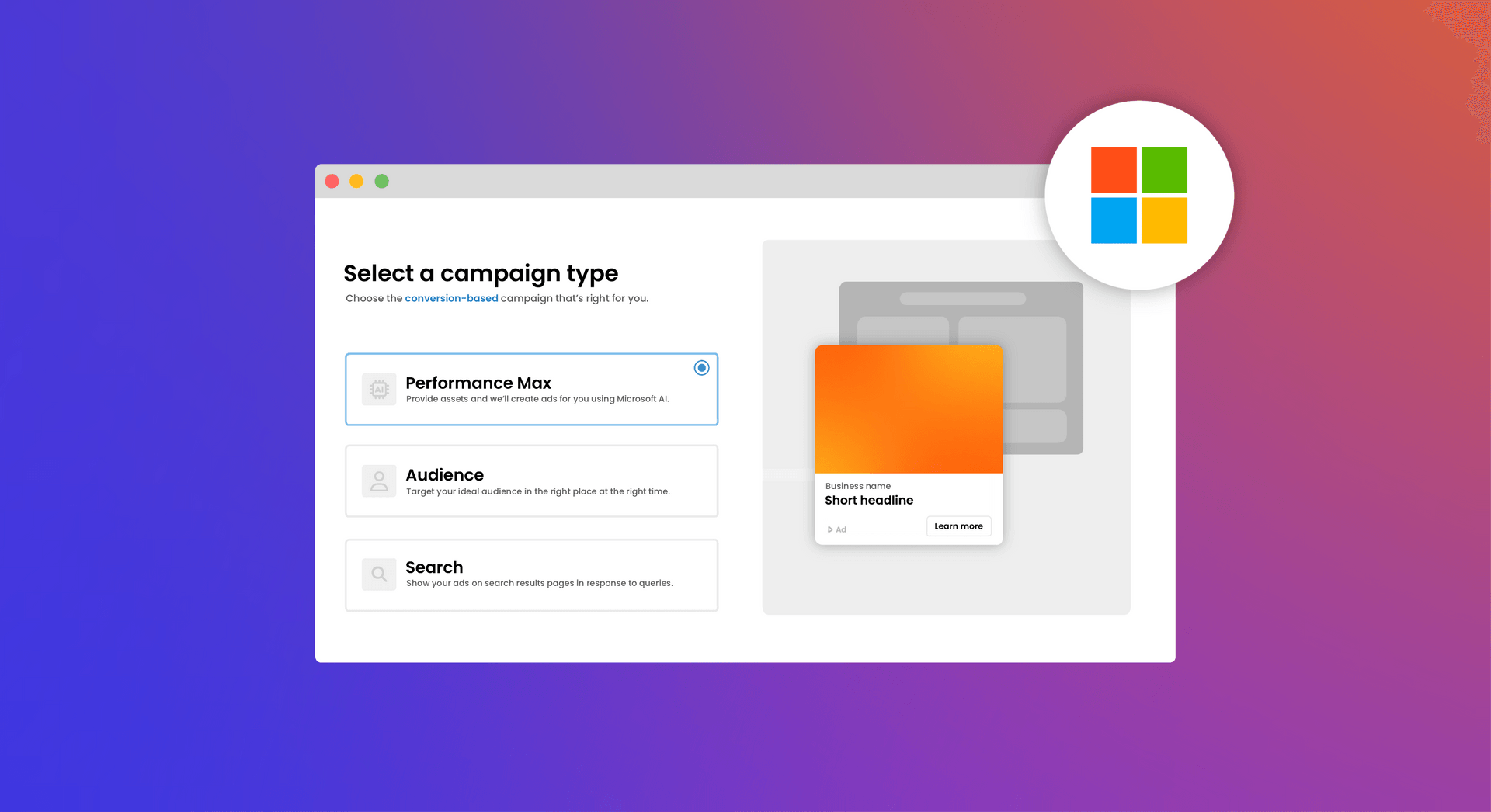Since their introduction, Google’s Performance Max campaigns have succeeded in both amplifying ad engagement and streamlining workflows for marketers across the board.
Aiming to replicate Google’s success for the Microsoft network, Microsoft recently announced their own version of Performance Max campaigns. The beta launched on July 5th 2023, and is was rolled out globally on 5th March 2024.
Microsoft hasn’t exactly been creative here, using the same name as Google for their Performance Max campaigns. Microsoft’s version of Performance Max comes a full three years after Google’s Performance Max was first made available in beta.
Marketers aiming to make the most out of their ad spend will need to understand the key differences between the Google and Microsoft versions of Performance Max, and optimize their campaigns for each platform.
Here, we’ll walk you through everything you need to know about Microsoft Performance Max, including:
- The basics of Microsoft Performance Max
- How Microsoft Performance Max compares with Google Performance Max
- How to set up a Microsoft PMax campaign
What is Microsoft Performance Max?
According to Microsoft, “Performance Max is an asset-focused campaign type that allows you to easily create and manage your campaigns, optimize ads to reach the right audience at the right time, and drive performance to meet advertising goals—across the entire Microsoft Advertising Network. Rather than manually creating ads one by one, you can save time by adding assets, such as text and images, to your asset groups and let us take care of the rest.”
The primary goal of Microsoft Performance Max campaigns are to find and convert more customers across the entire Microsoft network. It does so by pairing the right creative assets with the right targeting parameters in real time.
Performance Max campaigns use Microsoft AI to optimize and manage ads across various channels and formats within the Microsoft Advertising Network.
When Should You Use Microsoft Performance Max?
According to Microsoft’s documentation, Microsoft PMax is the best option to use when you want to:
- Meet specific performance goals, such as increasing sales and driving potential customers to your website. Do so by leveraging machine learning and AI to optimize ad delivery across channels.
- Enhance your return on ad spend and maximize reach across the entire Microsoft Advertising Network. PMax helps utilize audience targeting to deliver ads to the most relevant audiences at the right time across different platforms.
- Display your ads across the entire Microsoft Advertising Network with a single campaign. When you run a PMax campaign, Microsoft shows your ads across all channels – Bing, Yahoo, and Microsoft Audience Network partner sites.
- Expand your ad reach and increase conversion value by serving search, audience, and product ads.
Advertise to Humans, Not Bots
Save up to 20% of your advertising budget by automatically eliminating fake ad clicks across all paid channels.
Key Benefits of Microsoft Performance Max
There are four key benefits of Microsoft PMax:
1. Run Ads Across All Microsoft Channels
The best part about Microsoft PMax campaigns is that you can run ads across the entire Microsoft Network from a single campaign. This is perfect for businesses with small ad budgets who don’t have an in-house team to set up every individual channel for their ad campaigns.
2. Save Time
Performance Max campaigns save marketers time by allowing them to create a single campaign that targets multiple ads and channels, streamlining the workflow for marketers..
Those who use PMax campaigns won’t have to manage multiple ad campaigns simultaneously. Instead, promote products via a singular campaign, and PMax’s automation serves your creatives to the right audience, on the right platform, at the right time.
3. Use AI and Automation to Maximize ROAS
Performance Max campaigns leverage AI and automation to keep up with customer trends, selecting the best possible asset combination for your ads. The AI updates these ads in real time to boost conversion value and achieve campaign objectives.
4. Complement Search Campaigns
Performance Max is designed to complement your keyword-based search campaigns. It helps you find more converting customers across all of Microsoft’s channels rather than relying solely on a keyword-based approach.
This can futureproof your campaigns as Microsoft follows Google on the move towards a keywordless future.
Microsoft Performance Max vs Google Performance Max
It’s no secret that Microsoft Performance Max is inspired by Google’s PMax version. Both share the same goal – to help marketers optimize campaigns,maximize performance, and streamline workflows
Despite the similarities, there are some differences between the two:
| Feature | Microsoft Performance Max | Google Performance Max |
| Platform | Microsoft’s advertising network, including Bing Search, Microsoft Audience Network, and Microsoft Start. | Across all Google channels, including Search, Display, YouTube, Gmail, Maps, and other Google properties. |
| Objective | Drive conversions and campaign goals across Microsoft Advertising Network, optimizing for actions like website purchases, leads, or other conversion events. | Maximize conversion value across Google’s channels, using automated bidding and ad creation to drive desired customer actions like online sales, lead generation, or app downloads. |
| Features | Automated targeting across Microsoft’s properties. Use audience signals and contextual relevance to show ads across search, web, video, and more. Optimize bids and creatives in real-time. | Utilize automated bidding and creative optimization across Google’s channels. Leverage audience signals and contextual relevance to deliver the most relevant ads for each channel. |
| Integration | Integrates with Microsoft Advertising ecosystem – Microsoft Audience Network, LinkedIn Profile Targeting, etc. | Integrates with Google Ads ecosystem – Google Analytics, Google Tag Manager, etc. |
| Target Audience | Advertisers looking to target users across Bing, Yahoo, AOL, etc. | Advertisers looking to target users across Google Search, YouTube, and other Google properties. |
| Optimization strategy | Uses advanced machine learning to optimize bids, targeting, creatives, and delivery automatically. | Uses automated bidding and ad creation strategies to optimize for the goal you choose. |
| Cost | Lower CPC but smaller audience | Comparatively higher CPC |
| Flexibility | Medium (Set and forget) | Medium (Set and forget) |
| Ad types | Lets you create cruise ads, credit card ads, and professional service ads. | Lets you create search, display, YouTube ads, and more. |
Apart from the differences above, one major difference between MS PMax and Google PMax is the division of products into asset groups.
In Google PMax campaigns, each asset group can accommodate a maximum of 998 products. Whereas for Microsoft PMax campaigns, each asset group can accommodate a maximum of 19,998 products.
Microsoft Performance Max: Specifications & Requirements
There are three parts where specifications and requirements in the Microsoft PMax campaigns matter the most.
1. Images
If you want to try Microsoft Performance Max campaigns, you must meet the following requirements:
- Set conversion goals via your Universal Event Track (UET) tag and/or offline conversion tracking
- Enable revenue tracking in order to use the Max Conversion Value bid strategy
- Provide creatives with at least the following image dimensions:
- 1.91:1 – Minimum: 703 x 368
- 1:1 – 300 x 300
Microsoft Performance Max lets you select images from the current collection in your asset library, website images, stock images, or upload images.
The maximum number of pictures you can incorporate into a single ad campaign is 20. But, when uploading then, remember these two things:
- Upload at least one image with a resolution – 1.91:1
- Upload at least one image with a 1:1 aspect ratio
Lastly, always opt for high-resolution images in .JPG or .PNG format, and before uploading, ensure your images adhere to all guidelines.
| Aspect ratio | Image dimensions (pixels) |
| Must have | |
| 1.91:1 | Minimum: 703 x 368Recommended: 1200 x 628 |
| 1:1 | Minimum: 300 x 300Recommended: 1200 x 1200 |
| Additional aspect ratios (highly recommended) | |
| 1:2 | Minimum: 470 x 940Recommended: 600 x 1200 |
| 4:1 | Minimum: 608 x 152Recommended: 1200 x 300 |
| 1.5:1 | Minimum: 300 x 200Recommended: 1200 x 800 |
| 1.33:1 | Minimum: 100 x 75Recommended: 1200 x 900 |
| 1.78:1 | Minimum: 624 x 350Recommended: 1200 x 674 |
2. Headline
With Microsoft PMax, you have the option to input a maximum of 15 short headlines and up to 5 long headlines.
We recommend providing as many headlines as possible; it increases display visibility.
Note: Short headlines should not exceed 30 characters, while long headlines should not exceed 90 characters.
3. Description
Enter up to five 90-character descriptions. Descriptions are the most visible text of your ad and allow for more character space to engage with potential customers.
Now that you know what Microsoft Performance Max campaigns are all about, let’s compare its specifications and requirements with Google’s PMax.
| Microsoft Performance Max | Google Performance Max | |
| Images | Landscape and Square | Landscape, Portrait, or Square |
| Videos | None | Up to 5 YouTube videos |
| Headlines | From 3 to 15 | Only 3-5 |
| Description | Maximum 90 characters | First description limit 60 characters, all others 90 |
| Business name | Optional | Required |
| Call to action | 91 options | 18 options |
| Product in asset groups | Maximum 19,998 | Maximum 998 |
| Asset groups | Maximum 100 | Maximum 100 |
How to Set Up a Microsoft Performance Max Campaign
Before setting up a Microsoft Performance Max campaign, you must set up conversion tracking.
“Since Performance Max relies heavily on automation, it needs conversion signals to have any chance to improve ad performance with automation.” – Joe Martinez
After you have the conversion tracking set up, follow the steps below:
Step 1. Create a New Campaign
Click the ‘+Create’ button on your Microsoft campaign viewer to start a new campaign.
Step 2. Select Campaign Objective
There are a variety of campaign objectives to choose from, but remember – Performance Max isn’t available for all objectives.
For example, video views won’t give you an option to run a Performance Max campaign, whereas campaign objectives like Selling products from your catalog will have Performance Max.
For this example, we are going to select the Visit to My Website objective as it has performance max enabled.
Choose Performance Max and click ‘Next.’
The maximum number of pictures you can incorporate into a single ad campaign is 20. But, when uploading then, remember these two things:
- Upload at least one image with a resolution – 1.91:1
- Upload at least one image with a 1:1 aspect ratio
Finally, always opt for high-resolution images in .JPG or .PNG format, and before uploading, ensure your images adhere to all guidelines.
| Aspect ratio | Image dimensions (pixels) |
| Must have | |
| 1.91:1 | Minimum: 703 x 368Recommended: 1200 x 628 |
| 1:1 | Minimum: 300 x 300Recommended: 1200 x 1200 |
| Additional aspect ratios (highly recommended) | |
| 1:2 | Minimum: 470 x 940Recommended: 600 x 1200 |
| 4:1 | Minimum: 608 x 152Recommended: 1200 x 300 |
| 1.5:1 | Minimum: 300 x 200Recommended: 1200 x 800 |
| 1.33:1 | Minimum: 100 x 75Recommended: 1200 x 900 |
| 1.78:1 | Minimum: 624 x 350Recommended: 1200 x 674 |
Step 3. Campaign Details
Enter the details of your campaign:
- Name
- Budget & bid strategy
- Location
- Language
- Conversions
- Shopping settings
- Ad schedule
- Final URL expansion
- Campaign URL options
After filling in all the details, click the ‘Save & go to the next step’ button.
Step 4. Ad Copy Creation
The next step is all about your ad copy, image, headline, and CTA.
First, go ahead and paste the URL you want ad viewers to land on.
Add images according to the specifications and requirements we talked about earlier. As you add images, you can see how your ad will look in the preview window on the right-hand side.
If you need to edit the aspect ratio of any image, in the preview window, click the ‘Edit aspect ratio’ button and crop it accordingly.
Next, add your logo:
Now for the main part – your ad copy:
Add up to 15 short headlines, 5 long headings, and 5 descriptions.
Step 5. Adding Audience Signals
“Although setting up audience signals part is optional, I highly recommend you give Microsoft some signals of who you actually want to reach.” – Joe Martinez.
Either create a new audience signal or browse from existing options.
Let’s first see how to create a new one.Click ‘Create.’
Name your audience signal.
The Interests tab lets you add Microsoft in-market audiences to your asset group.
Add the audience you want to target and save it by clicking the Save button.
As this is a remarketing campaign, we will use first-party data to retarget people who previously interacted with my website.
Next, go to ‘Your first-part data.’ Click the ‘+ Add audience list.’
This option will let you choose from any existing audience you have created within Microsoft ads.
The last section is Demographics, where you can choose the range of ages and genders you want to target.
Once everything is finalized, click Save.
Choose the start and end date, and click Save to save your asset group.
Note: After your ad has been reviewed and approved by Microsoft, you’ll still have to wait a while for your campaign to go live. That’s because Performance Max campaigns have a learning phase – It could take up to two weeks for your PMax campaign to run optimized ads.
Step 6. Adding Extensions
From the left side menu, click the Extensions option.
Click ‘View: Sitelink Extension’ and select the Sitelink from the existing ones.
How to Optimize Microsoft Performance Max Campaigns
Once everything is up and running, view the status and track campaigns as you do with your regular campaigns.
Pro tip: Click the Segment dropdown and sort ads by Network. This will help you break things down and see how your PMax campaign is performing on different Microsoft Ads networks.
Here are some tips to optimize Microsoft Performance Max campaigns:
- Performance Max optimizes based on the types of conversions that you indicate are worth most to your business, so ensure you’re pointing Microsoft in the right direction.
- Provide as many high-quality text and images as possible to Microsoft so it can create the most relevant ads.
- Setting up audience signals is optional in Microsoft PMax, but we suggest you give Microsoft information about your audience – it can help speed up the learning and optimization process of your campaign.
Frequently Asked Questions
What is the learning phase for Microsoft Performance Max campaigns?
The learning phase of the Microsoft Performance Max campaign is where it uses machine learning and AI to optimize ad campaigns.
Performance max campaigns should go live in about ten days after you set them up. The average learning period after optimizations and adding new assets should be one to two weeks.
Is it necessary to generate keywords for my Performance Max campaigns?
No, you don’t need to maintain a keyword list for Microsoft PMax campaigns. Performance Max campaigns use keywordless AI technology to analyze your landing page content, assets, and product feed (if you have one) to find new converting queries and generate relevant text ads that match a user’s search.
Are there any Microsoft guides I can go through to know more about PMax campaigns?
Visit Microsoft Advertising Learning Lab to read more about Performance Max.
Wrapping Up
The digital marketing landscape is currently undergoing some major changes, with giants like Google and now Microsoft continuously innovating with the help of AI and machine learning.
Microsoft Performance Max campaigns bring a lot of unique strengths to the table, and by understanding your target audience and business objectives, you can leverage the platform to drive outstanding results and maximise ROAS.
Ensure you continue to test, optimize, and refine your Microsoft PMax campaign strategies for the best outcome.
Combat Fake Clicks with Lunio
Fake clicks are becoming increasingly problematic in the digital world. Invalid traffic wastes more of your ad spend than you think, with 1 in 12 clicks being invalid.
Lunio works to protect your campaign budgets and prevent invalid traffic, ensuring your ads are only seen by real customers.
See how much invalid traffic is affecting your PPC success (and how much you can save by eliminating it) with a free traffic audit.
Advertise to Humans, Not Bots
Save up to 20% of your advertising budget by automatically eliminating fake ad clicks across all paid channels.
























